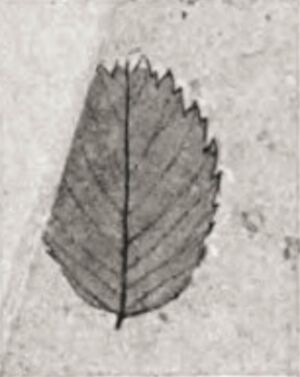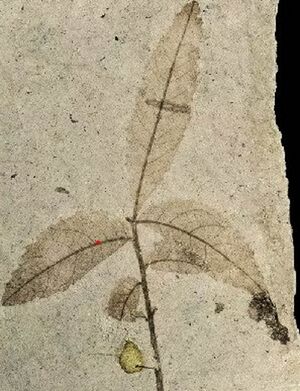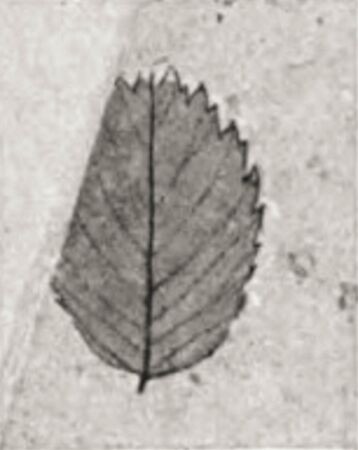Rosa alvordensis Axelrod
Fossile-Rose, 1944 - beschrieben vom Paläobotaniker/ described by the palaeobotanist/ décrit par le paléobotaniste Daniel Isaac Axelrod, USA
Eltern/ parentage/ parents: Botanische Rose/ Wild Rose/ Rosier botanique
Vermutliche Synonyme/ Presumed synonyms/ synonymes présumés: Rosa hilliae Lesq., Rosa dubia C.O.Weber
Die Synonyme wurden beschrieben von den Botanikern/ The synonyms were described by the botanists/ Les synonymes ont été décrits par les botanistes Daniel Isaac Axelrod, USA, Shigeru Miki, Japan, Hermann Engelhardt, Deutschland, Charles Arthur Hollick, USA, Ralph Works Chaney, USA, Frank Hall Knowlton, USA, Gábor (Gabriel) Andreánszky, Ungarn, Oswald von Heer, Schweiz, Theodore Dru Alison Cockerell, USA, Hsen Hsu Hu, China, Toshimasa Tanai, Japan, Wladyslaw Szafer, Polen
Allgemeines • Preface • Remarques
Der Paläobotaniker Daniel Isaac Axelrod gab der Rose ihren Namen nach dem Fundort, dem Alvord Creek[1], im südlichen Oregon, USA. Der Fund stammt aus dem Frühen Pliozän[2], ist also 5,333 - 3,6 Mio. Jahre alt.
The palaeobotanist Daniel Isaac Axelrod named the rose after the place where it was found, Alvord Creek[1], in southern Oregon, USA. The find dates from the Early Pliocene[2], i.e. it is 5.333 - 3.6 million years old.
Le paléobotaniste Daniel Isaac Axelrod a donné à la rose son nom d'après le lieu où elle a été trouvée, Alvord Creek[1], dans le sud de l'Oregon, aux États-Unis. La découverte date du début du Pliocène[2], soit de 5,333 à 3,6 millions d'années.
Originale Beschreibung • Original description • Description originale
Übersetzung:
Rosa alvordensis new species
(Plate 44, figure 5)
Beschreibung. Fiederblättchen oval, oben und unten abgerundet; 2,0 bis 3,0 cm. (geschätzt) 2,0 bis 3,0 cm. lang und 1,4 bis 2,2 cm. breit; Blattstiel kurz; Mittelrippe gerade und fest; wechselständige Nebenblätter, die im unteren Teil der Blattspreite in einem Winkel von 60° und im oberen Teil in einem Winkel von 40° auseinandergehen und sich im äußeren Teil der Blattspreite verzweigen, um Randzähne zu bilden, subcamptodrom; Tertiärblätter unregelmäßig; Rand halbmondförmig, mit scharfen Zähnen nach vorne gerichtet; Textur dünn.
Diskussion. Mehrere Fiederblättchen in der Flora gehören zweifellos zu Rosa und unterscheiden sich von den etwas ähnlichen Blättern von Amelanchier durch ihre zahlreicheren Nebenblätter und durch die Zähne, die typischerweise biserrate und scharf sind.
Die Alvord-Creek-Fiederblättchen unterscheiden sich von denen, die in der Flora des Bridge Creek als Rosa hilliae Lesquereux (Chaney, 1927, S. 123, Taf. 13, Abb. 8, 9; Taf. 14, Abb. 1) abgebildet sind; grundlegende Unterschiede sind sowohl in der Form als auch im Rand erkennbar. Auch die verschiedenen beschriebenen Rosa-Arten aus Florissant sind eher mit den Arten aus Bridge Creek als mit denen aus Alvord Creek verwandt.
Bei einer Gattung wie Rosa ist es natürlich nicht möglich, die Verwandtschaft zwischen einer fossilen Art und einer lebenden Pflanze anzugeben. Es reicht vielleicht aus, darauf hinzuweisen, dass der Alvord Creek eine enge Verwandtschaft mit einer Reihe von westlichen Arten aufweist, wie Rosa gymnocarpa Nuttall, R. californica Chamisso and Schlechtendal, R. pisocarpa Gray, und R. ultramontana Watson.
Sammlung. U. C. Mus. Pal., Paleobot. Ser., Holotypus, Nr. 2124; Nr. 2125
Original:
Rosa alvordensis new species
(Plate 44, figure 5)
Description. Leaflets oval, rounded above and below; 2.0 to 3.0 cm. (estimated) long and 1.4 to 2.2 cm. wide; petiolule short; midrib straight and firm; alternate secondaries diverging at from 60° in the lower part of the blade to 40° in the upper part, bifurcating in the outer part of the blade to supply marginal teeth, subcamptodrome; tertiaries irregular; margin biserrate, with sharp teeth directed forward; texture thin.
Discussion. Several leaflets in the flora are unquestionably those of Rosa, and can be distinguished from the somewhat similar leaves of Amelanchier by their more numerous secondaries and by the teeth, which are typically biserrate and sharp.
The Alvord Creek leaflets are distinct from those figured from the Bridge Creek flora as Rosa hilliae Lesquereux (Chaney, 1927, p. 123, pl. 13, figs. 8, 9; pl. 14, fig. 1); fundamental differences are apparent in both shape and margin. Likewise, the several described Rosa species from Florissant are more nearly related to the Bridge Creek than to the Alvord Creek species.
In such a genus as Rosa it is obviously not possible to indicate relationship between a fossil species and any one living plant. It is perhaps sufficient to point out that the Alvord Creek shows close relationship to a number of western species, such as Rosa gymnocarpa Nuttall, R. californica Chamisso and Schlechtendal, R. pisocarpa Gray, and R. ultramontana Watson.
Collection. U. C. Mus. Pal., Paleobot. Ser., holotype, no. 2124; no. 2125
Traduction:
Rosa alvordensis new species
(Plate 44, figure 5)
Description. Folioles ovales, arrondies dessus et dessous ; 2,0 à 3,0 cm. (estimé) de long et 1,4 à 2,2 cm. de large ; pétiolule court ; nervure centrale droite et ferme ; secondaires alternées divergeant de 60° dans la partie inférieure du limbe à 40° dans la partie supérieure, bifurquant dans la partie externe du limbe pour fournir des dents marginales, subcamptodromes ; tertiaires irrégulières ; marge biserate, avec des dents aiguës dirigées vers l'avant ; texture fine.
Discussion. Plusieurs folioles de la flore sont incontestablement celles de Rosa, et se distinguent des feuilles d'Amelanchier quelque peu similaires par leurs secondaires plus nombreuses et par les dents qui sont typiquement biserées et aiguës.
Les folioles d'Alvord Creek sont distinctes de celles qui ont été décrites dans la flore de Bridge Creek comme Rosa hilliae Lesquereux (Chaney, 1927, p. 123, pl. 13, fig. 8, 9 ; pl. 14, fig. 1) ; des différences fondamentales sont apparentes à la fois dans la forme et dans les marges. De même, les plusieurs espèces de Rosa décrites à Florissant sont plus proches des espèces de Bridge Creek que de celles d'Alvord Creek.
Dans un genre comme Rosa, il n'est évidemment pas possible d'indiquer la parenté entre une espèce fossile et une plante vivante. Il suffit peut-être de souligner que l'espèce d'Alvord Creek présente des liens de parenté étroits avec un certain nombre d'espèces occidentales, telles que Rosa gymnocarpa Nuttall, R. californica Chamisso and Schlechtendal, R. pisocarpa Gray, et R. ultramontana Watson.
Collection. U. C. Mus. Pal., Paleobot. Ser., holotype, no. 2124 ; no. 2125
Fundort • Find location • Lieu de découverte
Gefunden wurde das fossile Blatt von Rosa alvordensis im Alvord Creek[1], im südlichen Oregon, USA, am Rande der Steen Mountain[3] und der Alvord Desert[4].
The fossilised leaflets of Rosa alvordensis were found in Alvord Creekk[1], in southern Oregon, USA, on the edge of Steen Mountain[3] and the Alvord Desert[4].
La feuille fossile de Rosa alvordensis a été trouvée à Alvord Creekk[1], dans le sud de l'Oregon, aux États-Unis, en bordure de Steen Mountain[3] et de l'Alvord Desert[4].
- Rosa alvordensis
Zum Vergrößern anklicken • click to enlarge • cliquez pour agrandir
↑ Nach oben • Top • Vers le haut ↑
Einzelnachweis • Footnotes • Notes
Weblinks • External links • Liens externes
Literatur • Literature • Littérature
- Ralph W. Chaney, Carlton Condit, Daniel I. Axelrod, Pliocene Floras of California and Oregon, 1944 Seite 259 - Text u.Tafel 44, Fig. 5
- Herman F. Becker, The fossil record of the genus Rosa, 1963 Rosa alvordensis


